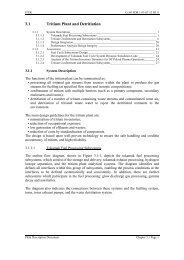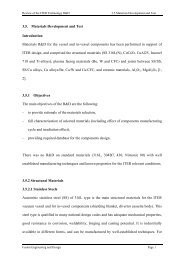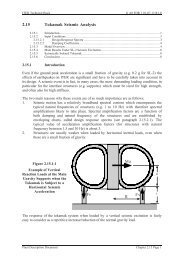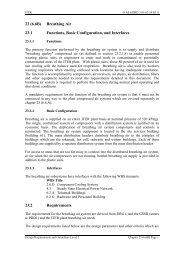3.7 Plant Control - General Atomics Fusion Group
3.7 Plant Control - General Atomics Fusion Group
3.7 Plant Control - General Atomics Fusion Group
You also want an ePaper? Increase the reach of your titles
YUMPU automatically turns print PDFs into web optimized ePapers that Google loves.
ITER G A0 FDR 1 01-07-13 R1.0<strong>3.7</strong>.4.2.6 NTM StabilisationITER can achieve its goal of Q ≥ 10 with β Nas low as 1.5 and even at fusion power levels of500 MW, β Nis ~ 2. Nevertheless, in present experiments with long-pulse, low collisionalityplasmas, neoclassical tearing modes (NTMs) can limit β and degrade energy confinementwithin the range of β Nforeseen for ITER operation 1(and well below the ideal mhd stabilitylimit). The predominant modes are (m,n) = (3,2) and (2,1), with the former typicallyproducing a 10-30% degradation in confinement, while the latter results in major disruptions.Although a scatter in available data does not allow a precise scaling of critical quantities, suchas the minimum seed island width, it has been found in several tokamaks that the minimum βfor the onset of NTMs falls approximately linearly 2 with the normalised Larmor radius ρ i*.If this scaling is valid in the range of small ρ i*, the critical β Nin ITER would be about 0.5,which is below the operational value. Since this prediction is based on limited data in therange far from ITER, and since at very low ρ i* the seed island is expected to be too small toovercome the stabilising factors (polarisation current and incomplete pressure flattening in theisland), usually higher estimates for critical β Nfor ITER are given 2 . However, given a largeuncertainty in prediction, it is necessary to develop NTM stabilising techniques.The growth time of NTMs is determined by the timescale for resistive reconnection in thevicinity of the relevant rational q surface, which is long enough to permit stabilisation byECCD in present experiments 3 , and should lie in the range 10–30 s in ITER. Therefore, anECCD-based stabilisation system for NTMs will be installed to suppress (3,2) and (2,1)modes. Two possibilities have been explored computationally: (i) mode stabilisation byECCD modulated in phase with the island O-point, and (ii) reduction in width of thesaturated island by continuous ECCD. Theoretical calculations show that a modulated ECCDcurrent density exceeding 1.5 times the bootstrap current density in the neighbourhood of therational surface (driven in the forward direction in the island O-point) will stabilise anarbitrarily small island.Initial analyses of power requirements have shown that (3,2) and (2,1) NTMs could bestabilised (individually) in a time of order 10 s by 10-30 MW of modulated ECCD power 4 indevices of the ITER class (see Figure <strong>3.7</strong>.4-12). There is a satisfactory agreement betweendifferent approaches. The scatter in the predictions is partly related to the island detectionsize. For example, an estimate of modulated ECCD power 5 for ITER varies from 28 MW forsaturated islands to 18 MW for a smaller detectable size of island w / a ≈ 0.04 (see Figure1O. Sauter, et al., Phys. Plasmas 4 (1997) 1654 M.N. Rosenbluth, Plasma Phys. <strong>Control</strong>. Fus. 41 (1999)2R.J. La Haye, et al., Phys. Plasmas 7 (2000) 33493H. Zohm, et al., Proc. 26th EPS Conf. on <strong>Control</strong>led <strong>Fusion</strong> and Plasma Physics (Maastricht, 1999) 13734G. Giruzzi, et al., Proc. 13th Topical Conf. on Applications of RF Power to Plasmas (Annapolis, USA,April, 1999) A.V. Zvonkov, “Electron Cyclotron Current Drive Optimisation for <strong>Control</strong> of NeoclassicalTearing Modes in RTO/RC-ITER” unpublished (1999)5V.D. Pustovitov, et al., 18th IAEA <strong>Fusion</strong> Energy Conference, Sorrento, (2000) IAEA-CN-77/ITERP/07<strong>Plant</strong> Description Document Chapter 3 .7 Page 38








